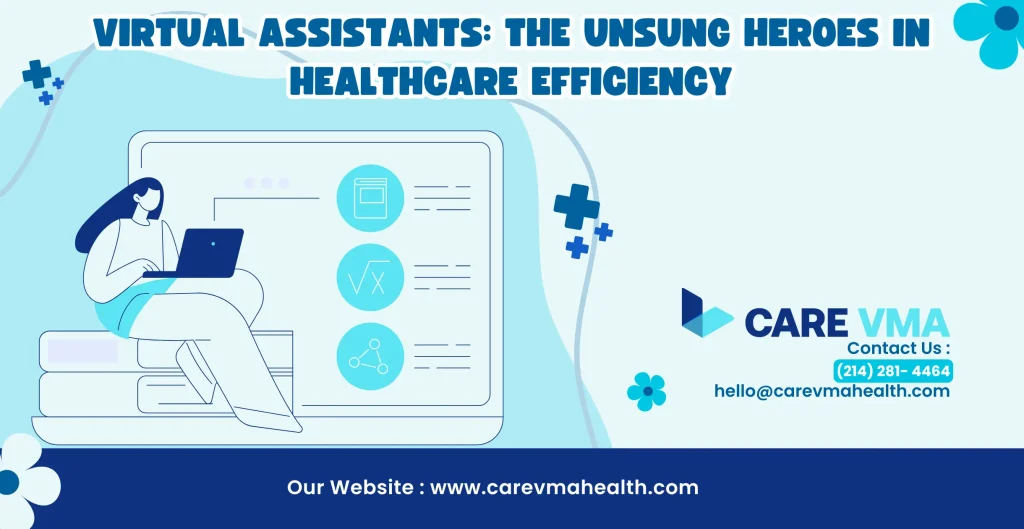Virtual assistant services are changing healthcare in the United States. With a market growth of CAGR 33.24%, the demand is growing fast. Many medical practices struggle with administrative work. This takes time away from patient care. A care medical VA helps by handling tasks like scheduling, billing, prescription refills, special referrals, and patient follow-ups. This reduces the workload for doctors and medical staff. They can focus more on treatment.
Healthcare is changing. More providers are using Virtual Assistants. This helps improve operations and patient satisfaction.
Table of Contents
Virtual Assistants Providing Professional Administrative Support
Virtual healthcare assistants started with simple tasks. They handled scheduling and data entry. However, the functions of remote assistants included patient communication, prescription referrals, calendar management, and insurance verifications as per the requirements of the practice. They also assist with billing and telehealth services.
- Front Desk Staff: A Virtual Assistant handles scheduling. They assist with check-ins and patient calls. This reduces wait times. It also allows in-house staff to focus on in-person needs.
- Handling Patient Communication: A remote healthcare assistant helps with follow-ups. They send appointment reminders and answer patient questions. This makes response times faster. It also reduces no-show rates.
- Managing Billing and Insurance Tasks: Many medical VAs assist with claims processing. They help with insurance verification and medical billing. This speeds up payments for medical practices.
- Supporting Telehealth Services: More providers are offering virtual care. The remote healthcare assistants schedule virtual visits. They also help patients before online consultations.
Virtual Medical Assistant Saving Practices from Financial Breakdown
The U.S. healthcare virtual assistant market is expected to grow to 12.99 billion by 2032. With the significant saving options, most healthcare practices have already adopted remote medical assistants as replacements for in-house staff. The often un-noticed Medical VAs do not demand any advance registration fee and do not ask for extra benefits. These administrative assistants work remotely and only charge for the hours they work for you.
Cost Factor | Virtual Medical Assistant | Onsite Medical Assistant | Source |
Base Salary | 35,000–45,000/year (remote workers often hired from lower-cost regions). | 45,000–60,000/year (higher in urban areas like NYC, SF). | BLS (2023) |
Health Insurance | Often not required (many work as contractors). If provided, plans are 15–20% cheaper. | Employers pay 6,000–12,000/year/employee for health insurance. | KFF Employer Health Benefits Survey (2023) |
Overhead Costs | 0–1,500/year (no clinical space or equipment; limited to HIPAA-compliant software fees). | 10,000–18,000/year/employee (clinical space, utilities, medical equipment, supplies). | Health Affairs (2021) |
Training | Lower turnover (remote roles report 20% higher retention). Training costs are similar. | High turnover (clinics report 30–40% annual turnover). Recruitment costs 3,000–5,000. | MGMA (2023) |
Taxes | Employers save 7.65% on FICA taxes if workers are contractors (1099). | Full payroll taxes (7.65% employer contribution for W-2 employees). | IRS Guidelines (2023) |
Bonuses & Incentives | Rarely offered (only 10–15% of remote contractors receive bonuses). | Common (25–35% receive annual bonuses, averaging 1,000–3,000). | Payscale Compensation Report (2023) |
Medical VAs Reducing Scheduling Errors & Documentation Backlogs
- Fewer Scheduling Errors: Healthcare remote assistants send reminders to patients. They confirm appointments to prevent double scheduling. This reduces missed appointments and increases hospital overall outcomes.
- Shorter Patient Wait Times: Handling phone calls and paperwork quickly allows front-desk staff to focus on in-person care.
- Better Documentation Management: Virtual Assistants update patient records. They transcribe medical notes. This reduces paperwork delays for doctors and nurses.
Virtual Assistant Streamlining Office Workflows for Medical Practices
The remote assistant for medical practices ensures the office operations run smoothly. From reducing the workload of healthcare staff with consistent paperwork to minimising providers’ burden with EHR management, virtual assistants just streamline the office workflows.
Enhancing Patient Engagement with Virtual Assistants
Wondering if virtual medical office assistants can actually help in engaging your patients? The answer is absolutely yes. The remote medical assistants not only communicate with your patients on your behalf but also provide patient support during consultations around the clock. Let’s explore in detail how healthcare assistants are secretly satisfying your patients.
Virtual Assistants Ensuring Secure and Efficient Practice Operations
Many providers believe virtual medical staff might be unsecured and can cause data breaches. To their knowledge, remote healthcare assistants are completely HIPAA compliant and use completely encrypted tools for office management.
Get the HIPAA-Compliant Virtual Assistants Today!
If you want to hire the best virtual medical assistance services in the USA, book your appointment with Care VMA Health today. The registered company provides the top HIPAA-compliant VAs, which not only support your medical staff in administrative tasks but also streamline practice operations like a professional onsite assistant. So, get your unsung hero onboard and let your patients speak for practice!
No credit card required – Easy onboarding

